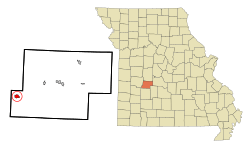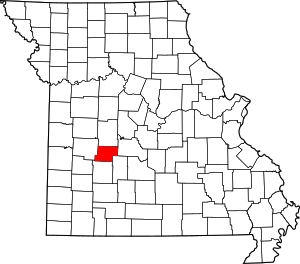Weaubleau, Missouri
Weaubleau is a town in Hickory County, Missouri, United States, founded in 1867.[6] The population was 418 at the 2010 census.
Weaubleau, Missouri | |
|---|---|
 Location of Weaubleau, Missouri | |
| Coordinates: 37°53′30″N 93°32′28″W | |
| Country | United States |
| State | Missouri |
| County | Hickory |
| Area | |
| • Total | 0.87 sq mi (2.26 km2) |
| • Land | 0.86 sq mi (2.24 km2) |
| • Water | 0.01 sq mi (0.02 km2) |
| Elevation | 978 ft (298 m) |
| Population | |
| • Total | 418 |
| • Estimate (2019)[3] | 410 |
| • Density | 473.99/sq mi (183.02/km2) |
| Time zone | UTC-6 (Central (CST)) |
| • Summer (DST) | UTC-5 (CDT) |
| ZIP code | 65774 |
| Area code(s) | 417 |
| FIPS code | 29-78064[4] |
| GNIS feature ID | 0728443[5] |
History
Weaubleau was first called Haran, but later renamed for the stream upon which it is located.[7] The town sprang up around the Weaubleau Christian College and Weaubleau Congregational Christian Church, which predated the town.[6]
Geography
Weaubleau is located at 37°53′30″N 93°32′28″W (37.891647, -93.540987).[8]
According to the United States Census Bureau, the city has a total area of 0.88 square miles (2.28 km2), of which 0.87 square miles (2.25 km2) is land and 0.01 square miles (0.03 km2) is water.[9]
Demographics
| Historical population | |||
|---|---|---|---|
| Census | Pop. | %± | |
| 1900 | 274 | — | |
| 1910 | 347 | 26.6% | |
| 1920 | 413 | 19.0% | |
| 1930 | 421 | 1.9% | |
| 1940 | 439 | 4.3% | |
| 1950 | 432 | −1.6% | |
| 1960 | 349 | −19.2% | |
| 1970 | 343 | −1.7% | |
| 1980 | 464 | 35.3% | |
| 1990 | 436 | −6.0% | |
| 2000 | 518 | 18.8% | |
| 2010 | 418 | −19.3% | |
| Est. 2019 | 410 | [3] | −1.9% |
| U.S. Decennial Census[10] | |||
2010 census
At the 2010 census there were 418 people in 190 households, including 111 families, in the city. The population density was 480.5 inhabitants per square mile (185.5/km2). There were 233 housing units at an average density of 267.8 per square mile (103.4/km2). The racial makup of the city was 97.4% White, 0.2% African American, 0.7% Native American, and 1.7% from two or more races.[2]
Of the 190 households, 26.8% had children under the age of 18 living with them, 42.1% were married couples living together, 13.2% had a female householder with no husband present, 3.2% had a male householder with no wife present, and 41.6% were non-families. 36.8% of households were one person, and 19.5% were one person aged 65 or older. The average household size was 2.20 and the average family size was 2.81.
The median age was 46.3 years. 21.1% of residents were under the age of 18; 7.1% were between the ages of 18 and 24; 20.3% were from 25 to 44; 30.2% were from 45 to 64; and 21.3% were 65 or older. The gender makeup of the city was 47.6% male and 52.4% female.
2000 census
At the 2000 census there were 518 people in 220 households, including 133 families, in the city. The population density was 590.8 people per square mile (227.3/km2). There were 257 housing units at an average density of 293.1 per square mile (112.8/km2). The racial makup of the city was 97.68% White, 0.19% African American, 0.58% Native American, 0.19% from other races, and 1.35% from two or more races. Hispanic or Latino of any race were 1.16%.[4]
Of the 220 households, 29.1% had children under the age of 18 living with them, 47.3% were married couples living together, 9.1% had a female householder with no husband present, and 39.5% were non-families. 33.2% of households were one person, and 19.5% were one person aged 65 or older. The average household size was 2.35 and the average family size was 3.02.
In the city the population was spread out, with 26.3% under the age of 18, 8.1% from 18 to 24, 23.0% from 25 to 44, 21.2% from 45 to 64, and 21.4% 65 or older. The median age was 39 years. For every 100 females, there were 87.0 males. For every 100 females age 18 and over, there were 86.3 males.
The median household income was $18,750 and the median family income was $21,765. Males had a median income of $19,643 versus $20,139 for females. The per capita income for the city was $9,952. About 17.6% of families and 27.3% of the population were below the poverty line, including 43.2% of those under age 18 and 18.0% of those age 65 or over.
See also
References
- "2019 U.S. Gazetteer Files". United States Census Bureau. Retrieved July 26, 2020.
- "U.S. Census website". United States Census Bureau. Retrieved 2012-07-08.
- "Population and Housing Unit Estimates". United States Census Bureau. May 24, 2020. Retrieved May 27, 2020.
- "U.S. Census website". United States Census Bureau. Retrieved 2008-01-31.
- "US Board on Geographic Names". United States Geological Survey. 2007-10-25. Retrieved 2008-01-31.
- Harryman, Eugene. "Weaubleau Congregational Christian Church". Weaubleau Congregational Christian Church. Retrieved 1 December 2015.
- Eaton, David Wolfe (1916). How Missouri Counties, Towns and Streams Were Named. The State Historical Society of Missouri. pp. 173.
- "US Gazetteer files: 2010, 2000, and 1990". United States Census Bureau. 2011-02-12. Retrieved 2011-04-23.
- "US Gazetteer files 2010". United States Census Bureau. Retrieved 2012-07-08.
- "Census of Population and Housing". Census.gov. Retrieved June 4, 2015.
